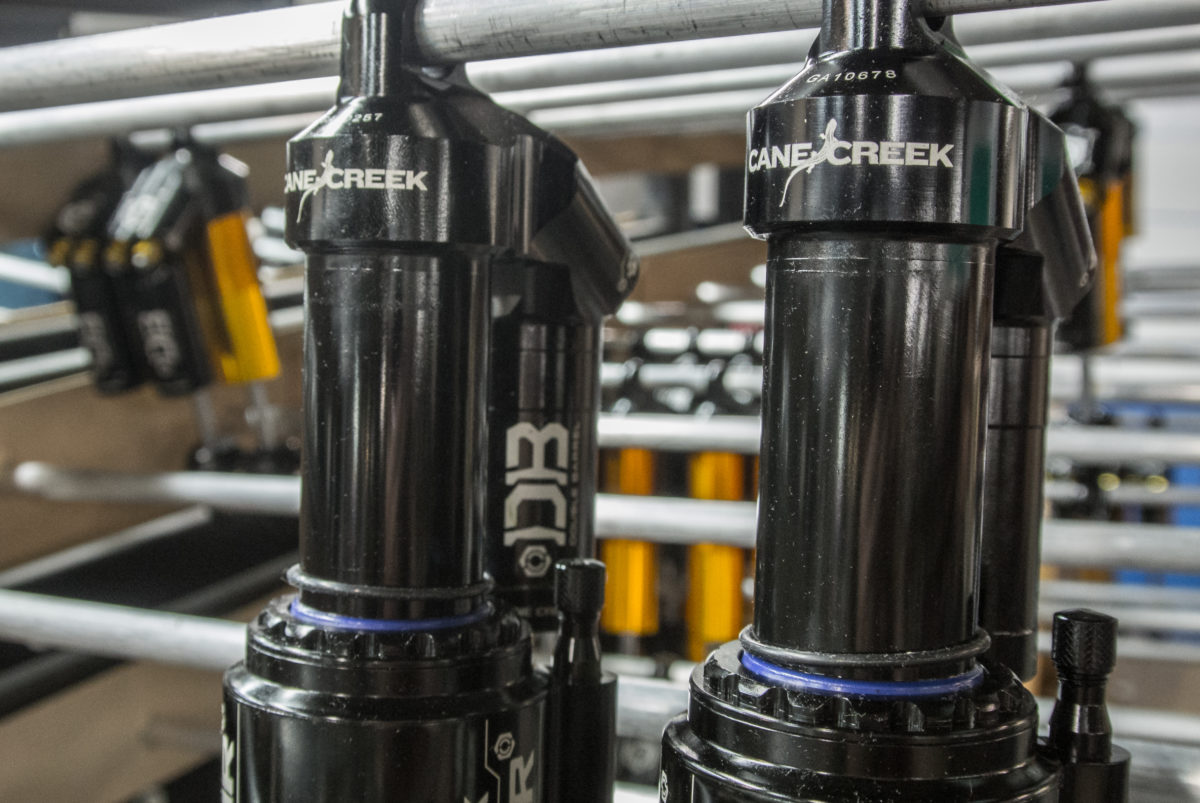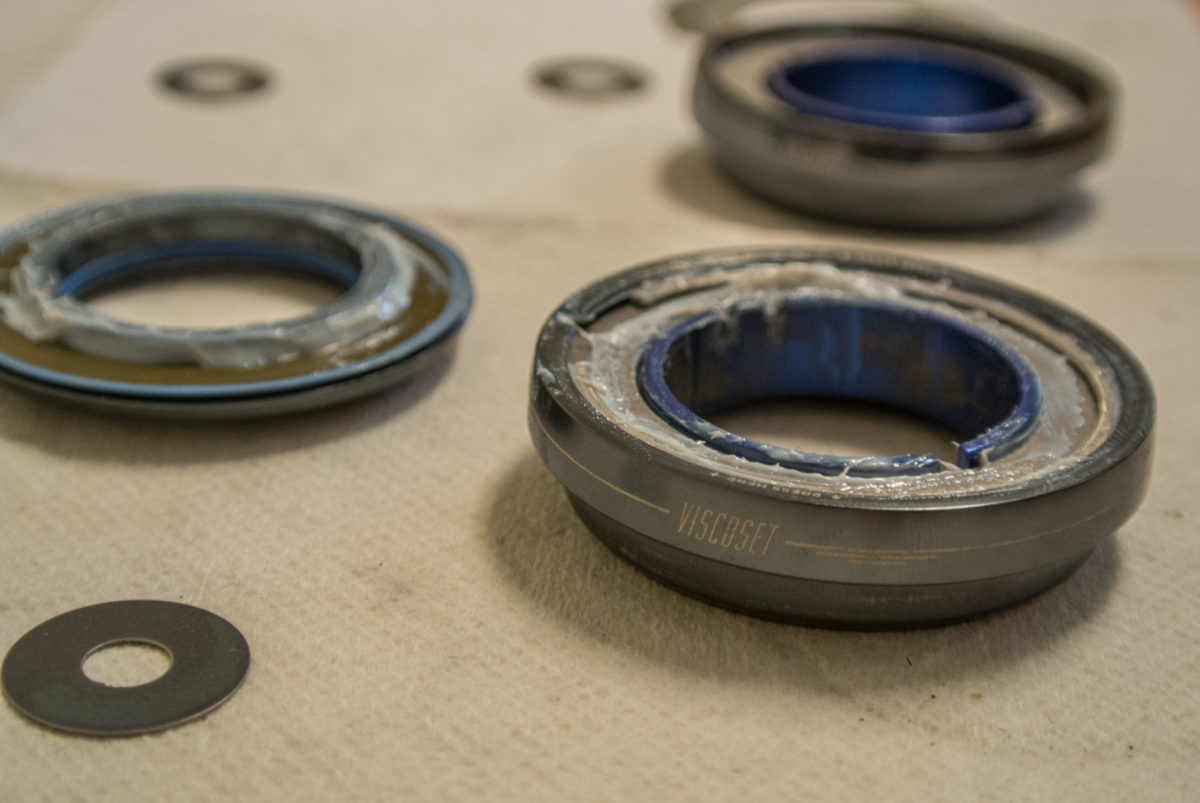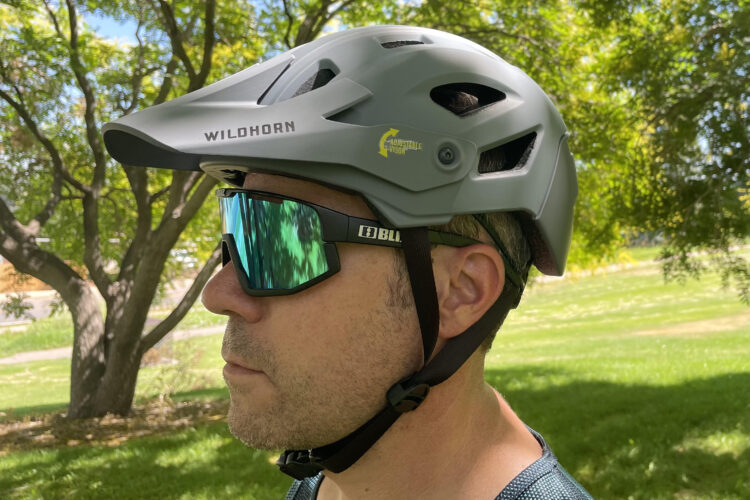
During a recent trip to Western North Carolina, I stopped by Cane Creek’s headquarters for a tour and to check out some new products. Their facility is in Fletcher, NC, about 15 miles south of Asheville. It is an older, large, nondescript building off a quiet country road. Inside, however, employees are busy assembling shocks, bagging headsets, and designing new products.
The original schedule called for a tour in the morning followed by a ride in the afternoon, but with rain looming we called an audible and headed out for the ride first. My guide was Bryan Flack, their Retail Services Coordinator. At the time, Cane Creek was getting ready to launch a new shock aimed at garnering a larger OE business, the C-Quent. BMC is one of their first customers, and Cane Creek had a fleet of Speedfox Trailcrews for testing.
The hallmarks of Cane Creek’s suspension have been the use of a twin tube damper and tons of adjustability. For the average rider, all that adjustment can be intimidating. The C-Quent still uses a twin tube damper, but it comes with a base tune set at the factory. Cane Creek works with their OE partners to develop the base tune for a specific bike. External adjustments are limited to a knob for low speed rebound and Cane Creek’s Climb Switch.

For our ride, we headed over to the nearby Mills River area of the Pisgah National Forest. The ride featured a little bit of everything: gravel, punchy climbs, and flowy descents punctuated with rock gardens. Having opted for Cane Creek suspension on my personal bike, the C-Quent immediately felt familiar–plush, smooth, and controlled. Bryan and I timed our finish perfectly, as the skies opened up just after we loaded up in his truck. After a stop at the Sierra Nevada Brewery for lunch, we headed back to the office.

Cane Creek’s OEM Sales guy, Sam Anderson, led me on a tour of their facility. Our first stop was the shock assembly area. All shocks are assembled in house, with parts machined in North Carolina as well as abroad. Monday through Thursday, for 10 hours each day, nine employees assemble the various shocks. Once a shock is finished being built, it goes on a dyno to make sure it was assembled correctly. When you see how many teeny-tiny pieces go into one of these shocks, you can see why this is such a crucial step in the process.



Sam also mentioned that Cane Creek is now offering direct service. Previously, if you needed a repair, you had to send your shock to a third party, such as Suspension Experts. Now, you can send your shock back to the people that put it together in the first place.
While we were walking around, something caught my eye. It was a DBAir, but instead of the typical silverish shaft, it was an all-black unit. Sam told me they had numerous requests for an all-black DBAir because riders wanted their shock to match a RockShox Pike. We mountain bikers can be a vain bunch, can’t we?

After checking out the shocks, we headed over to the headset area. All of Cane Creek’s headsets get bagged in house, which can be quite the task considering all the various options out there. Their top of the line headset, the 110, is manufactured right there in NC. Etching and anodizing is done elsewhere, but otherwise it is built inside their walls.


Cane Creek still sells a surprising number of their Thudbuster suspension seatposts–not to be confused with a dropper post. Sam told me the Thudbuster is popular in Europe where ebikes are much more commonplace than they are in the States. To deal with the extra weight of a motor and battery, ebike frames need to be burly. But that burliness comes with a corresponding sacrifice in ride quality. Installing a Thudbuster takes some of the sting out.



Once our tour was complete, Sam handed me off to Cane Creek’s Director of Engineering, Jim Morrison. We settled into the shop area of their new engineering wing, where Jim walked me through the C-Quent, in addition to another new shock, the DBCoil IL.
Jim told me the C-Quent project came about because of demand from OE customers. They wanted to spec Cane Creek’s DBInline, but the learning curve was too steep. For this project, they started with a clean slate, but ended up coming back to the twin tube damper design. Apart from having the knowledge base, the twin tube design offers significant benefits such as better heat management. The idea behind the C-Quent was to develop a shock with performance identical to the DBInline, but with only the most basic adjustments.

Our conversation also covered the DBCoil IL which at the time, had yet to be announced. One of their engineers, Brandon Blakely, had the idea to create a mashup of a DBCoil and a DBInline. Jim showed me the original prototype, a crude-looking Frankenshock built by Brandon after hours. The idea showed promise, so Cane Creek created additional prototypes, which were sent out for testing. When the feedback came in as overwhelmingly positive, the project went into production.

In conjunction with the DBCoil IL, Cane Creek developed a new, lighter weight spring to accompany it. The VALT line of springs uses a higher quality steel, which means they can use less material. Using less material means the springs are lighter than the standard steel springs Cane Creek has been offering. Depending on the size of the spring, they can be anywhere from 25-30% lighter. The DBCoil IL is intended to be run on short- to mid-travel bikes. They were kind enough to set me up with an IL, which I will be testing throughout the fall.
Cane Creek is also developing shocks for the new metric sizing option. Jim was excited about the possibilities the new sizes afford them from an engineering standpoint. With longer eye-to-eye measurements and a shorter stroke, there is more room inside the shock for the internals. If you have ever seen all that is packed inside a shock, you know real estate comes at a premium. A trunnion mount version of their shocks is also in development.

Other projects in the works include a bar-mounted remote for their Climb Switch, which came at the request of European customers. The Euros do seem to love their remotes.
Jim also showed me an interesting new headset that Cane Creek was getting ready to debut. Called “Viscoset,” the new headset acts as a steering damper. It is designed primarily for use on ebikes, where speed wobbles are a very real issue. With the motor, battery, and rider, there is an enormous rear weight bias. Taking your hands off the bars at speed could be a scary proposition. The Viscoset uses a series of keyed clutch plates and a special grease to slow the steering down. Conceivably, the idea could have off-road applications as well.

From my visit it was apparent that Cane Creek is thriving. All the employees seemed genuinely happy to work there and were excited about the future of the company. With their expanding product line, expect to see more bikes coming stock with Cane Creek’s components.
Thanks to Holly, Bryan, Sam, Jim, and the rest of the Cane Creek crew for showing me around!





















3 Comments
Nov 2, 2016
Nov 3, 2016
Nov 3, 2016